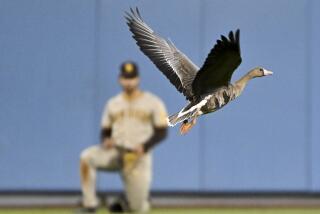D’Agostino First to Air TV Ads in City Attorney Race
- Share via
Goose has never been very important on the American table. It’s all dark meat, for one thing, and we already have a super-sized bird for festival occasions-the turkey, which has pretty much taken over the goose slot in our eating habits. Our turkey stuffings are adapted from European goose stuffings. Chestnut stuffing comes from France and Germany; bread crumbs and sage is typically English.
We all know about the goose the Cratchitts served in Dickens’ “A Christmas Carol.” In England, geese were also eaten at Michaelmas (Sept. 29), when they were nice and fat from eating the stubble left after the hay and grain harvests. These “stubble geese” were always stuffed.
But the English also used to prize what was called a green goose. Readers of Jane Austen’s “Mansfield Park” will remember Dr. Grant’s taste for green geese.
Was this a goose hung so long the flesh turned green? No, it was green in the opposite sense of being young. Geese sit their eggs in February, and the goslings hatch in March; the traditional season for green goose was Whitsuntide, mid-May through June, when they had grown a little.
Only a little, though. Green geese were so small that they were usually not stuffed. They took only half an hour of roasting (on a spit revolving in your fireplace), as against an hour and a half or more for an older goose. In some recipes, they’re wrapped with bacon to baste them, because they had little fat-a major distinction from fully grown geese, which are notoriously fatty.
In other words, green geese were not disgusting. They were even wholesomely lean, by today’s standards. We can’t blame them for Dr. Grant’s death by gluttony.
More to Read
Sign up for The Wild
We’ll help you find the best places to hike, bike and run, as well as the perfect silent spots for meditation and yoga.
You may occasionally receive promotional content from the Los Angeles Times.




